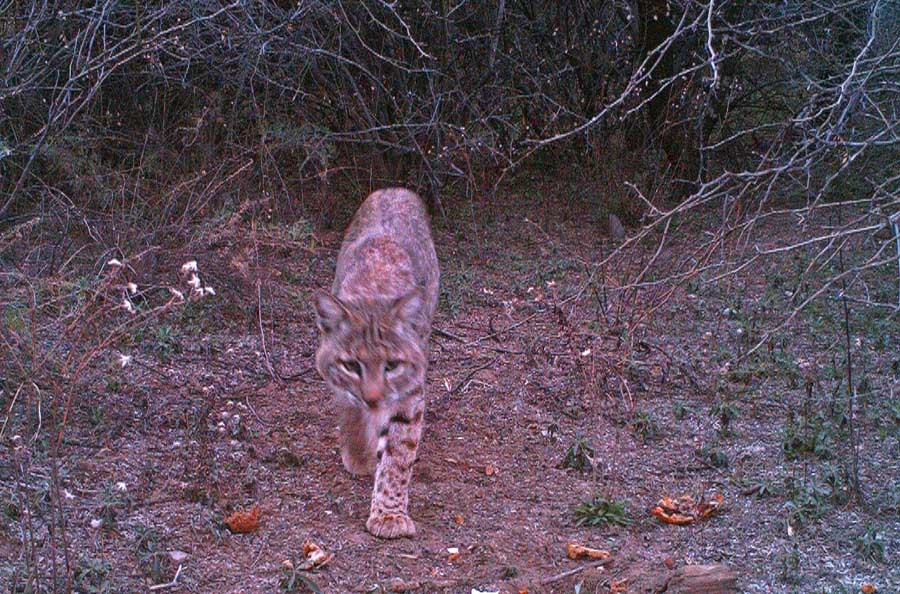
Bobcat (Lynx rufus)
Main sources: Nowak, Ronald, 1991, Walker's Mammals of the World, Fifth Edition (two vols.), Baltimore: Johns Hopkins University Press; Hoffmeister, D. F., 1986, Mammals of Arizona, Tucson: University of Arizona Press; Burt, W. & R. Grossenheider, eds., 1976, A Field Guide to the Mammals, Peterson Field Guides: Houghton Mifflin; Eisenberg, John, 1980, The Mammalian Radiations, Chicago: University of Chicago Press; Budiansky, Stephen, 2002, The Character of Cats: the Origins, Intelligence, Behavior, and Stratagems of Felis silvestris catus, NYC, Viking Press; (See also O'Brien, Stephen, & Warren Johnston, "Evolution of Cats", Scientific American July 2007, pp. 68-75.)
Above, a Bobcat captured by our HCO Scout Guard IR Camera 5MP Series SG550 in lower Hot Springs Canyon on January 6, 2009. [Note there is color distortion in this infrared image. See further below for some truer-color views.]
In the interest of accuracy, Bobcats should not be called "Wildcats", a taxonomic category referring to Felis silvestris, which on the basis of contemporary genetic analysis, includes not only African, European, nd Asian Wildcats, but also the domestic cat (Felis catus). Among themselves, domestic cats and these various subspecies of "True Wildcats" are so closely linked genetically that professional zoologists cannot reliably distinguish the skeletal remains of these four species. The similarity in appearance between our domestic cats and the Bobcat is deceptive, genetically speaking (though they do share some significant similarities in behavior, for example their typically solitary nature). See the domestic cat link marked out above for more details on matters of evolutionary lineages.
Recent DNA studies (see O'Brien & Johnston, cited above) show that Bobcats are members of the Lynx lineage of cats (which include Lynxes of North America and Eurasia as well as the Bobcat). All of these cats have short tails and pointed ears (see below). Native to North America, the Lynx lineage separated from the original cat migrants living here some 8 million years ago, and some of its members spread across the Bering Strait land bridge during Pliocene to early Pleistocene times. (the Iberian Lynx is the furthest western species in Eurasia.)
The Bobcat, Lynx rufus, is distinguished by its short tail, black only on top and at the tip (Hot Springs Canyon, January 9 2009:
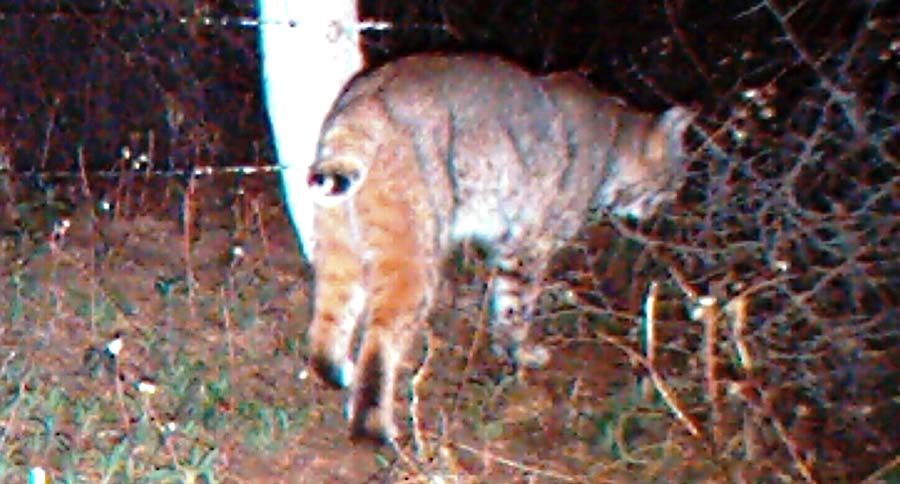
Note that the underpart of the tail tip is white, typical of the bobcats we have photographed. They seem to vary quite a bit in size, some approximating housecats, others like fairly sizeable dogs. Their legs seem long in relation to their bodies -- in contrast, for example, to gray foxes. This is also evident in the photo above, taken at night with our infra-red camera and its flash).
While bobcats have ear tufts, they tend to be short and rather inconspicuous in comparison to the northern Lynxes. This image below, from lower Hot Springs Canyon on January 17, 2009, doesn't show these tufts well (but see further below), but it does show the distinct pattern of black/white/brown coloring. Note also the clear view of the tail here.

Bobcats are mostly nocturnal and solitary, and they feed on small mammals and birds. They usually occupy a 2-3 mile radius of territory, in contrast to the Mountain Lion's much larger range. While we periodically see them on Saguaro Juniper lands, we have only been able to capture them with infrared cameras so far.
We have good daylight images from two outside sources, which provide further detail.
First, here below is a photograph of a bobcat residing at the Arizona-Sonora Desert Museum west of Tucson. While no doubt somewhat different from our local varieties, this close-up gives a fair sense of the animal's facial appearance, including the very small black ear-tufts:
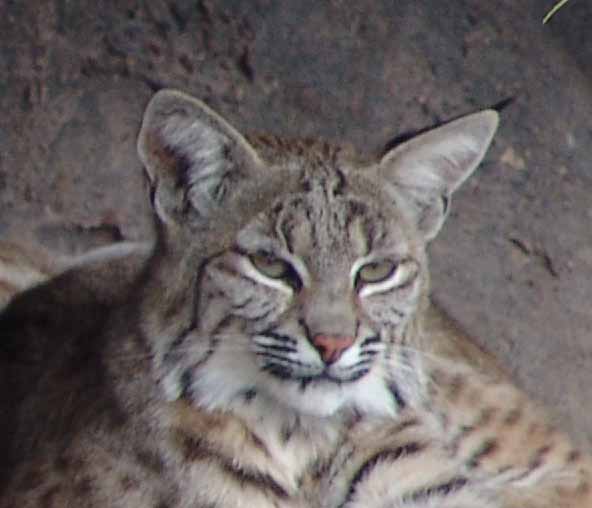
The yellowish tone of cats' eyes, somewhat evident in this picture but especially noticeable when they reflect bright light, is due to a reflective layer of tissue behind the retina which increases their capacity to see in darkness (Budiansky p. 120-21). Humans lacking this layer, we show "red eyes" (reflecting our blood vessels behind the retina) in response to bright light.
Second, in late September 2005, we received a set of Bobcat photographs from Randy Haugen, who lives on the northwestern flanks of the Catalina Foothills below Pusch Ridge, near Tucson. This small cat invaded the deck of the family house, where it briefly enjoyed the comfort of their deck chairs. Below left, a frontal view shows the patterning of colors from chin to chest, and also the distinctive black-and-white pattern on the backside of the ear (click on the image for an ear close-up). Below middle indicates the small size of the animal as it walks beneath the deck chair (this cat is probably a female, and about the size of an ordinary house cat, though with relatively longer legs). Note here the shape and coloring of the bob-tail which gives the cat its name -- the characteristic black tip only on the top has a white split in the middle, just like the one we photographed on Saguaro-Juniper lands (see above, and click on the image below for a tail enlargement). Below right, observe how large the ears are relative to the head, and how minor the ear-tufts are. (click on the image for a view of the white pattern below the chin.) Thanks to Mr. Haugen for allowing us to present these images.
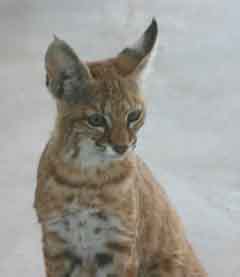 .
.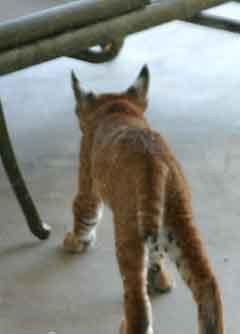 .
.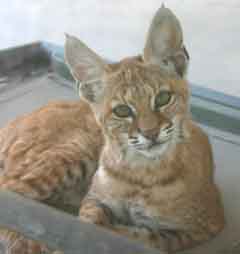
Third, on August 9, 2010, our Tucson neighbor Bown Litt saw this stalker in the family backyard (which has a six-foot-high fence), located in east-central Tucson near Alamo Wash. Note especially the color patterning behind the ears and along the back of the legs. As he watched, the cat easily jumped up and over the fence.
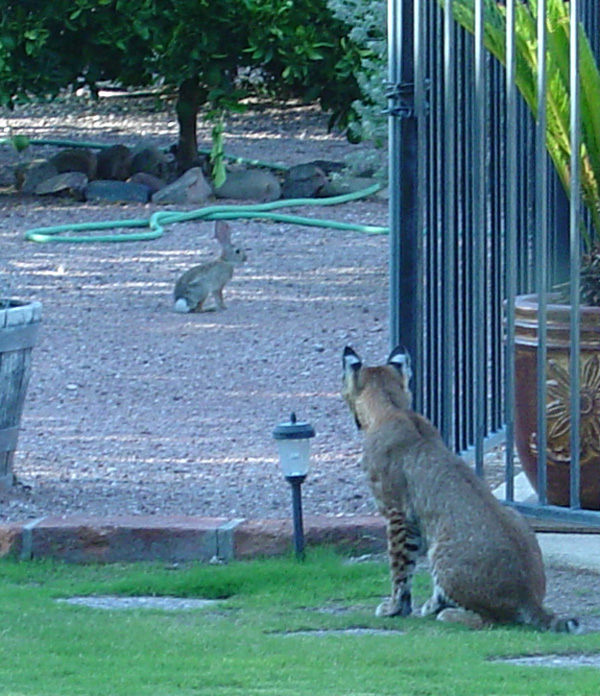
Return to Mammals